Design Based Learning (DBL) projects grounded in Design Thinking principles have journeyed from graduate design programs all the way to elementary classrooms. Design Thinking appeals to students of all ages because it empowers them to solve problems that are meaningful and that have the potential to change the world in a positive way. Students build cross-disciplinary knowledge and planning skills, learn to work collaboratively, and perhaps most important of all, practice and strengthen their ability to empathize with others.
Design Thinking
The Institute of Design at Stanford outlines the Design Thinking process as a series of five steps (summarized in Figure 1.1) that are repeated until the refined idea solves the user’s problem. Though Empathize is listed as the first discreet step, it is actually woven throughout the design process, integral to defining the problem, generating ideas, prototyping potential solutions and assessing, through testing, whether the needs identified in the Empathize phase are being sufficiently addressed.
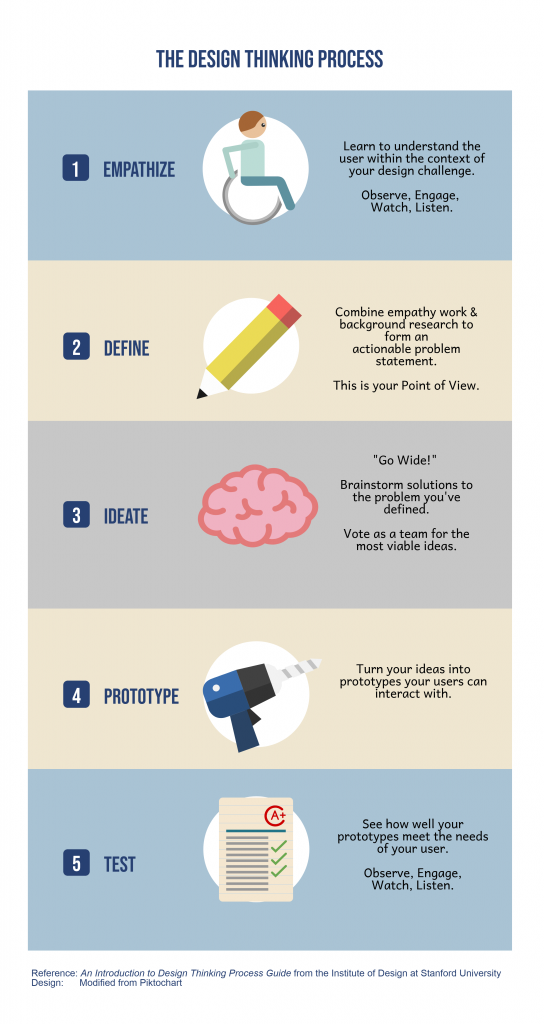
During the Empathize phase, designers seek to understand the needs of their user through background research, observation, interviews and context mapping. Context mapping helps designers reach beyond what a user does and says to a deeper understanding of their feelings, hopes, fears, and aspirations through techniques such as “cultural probes” that encourage users to describe their feelings (past, present, and future) about the area being studied (Kriek, 2018). Cultural probes can include journaling or “mood boards,” an example of which is shown in Figure 1.2.
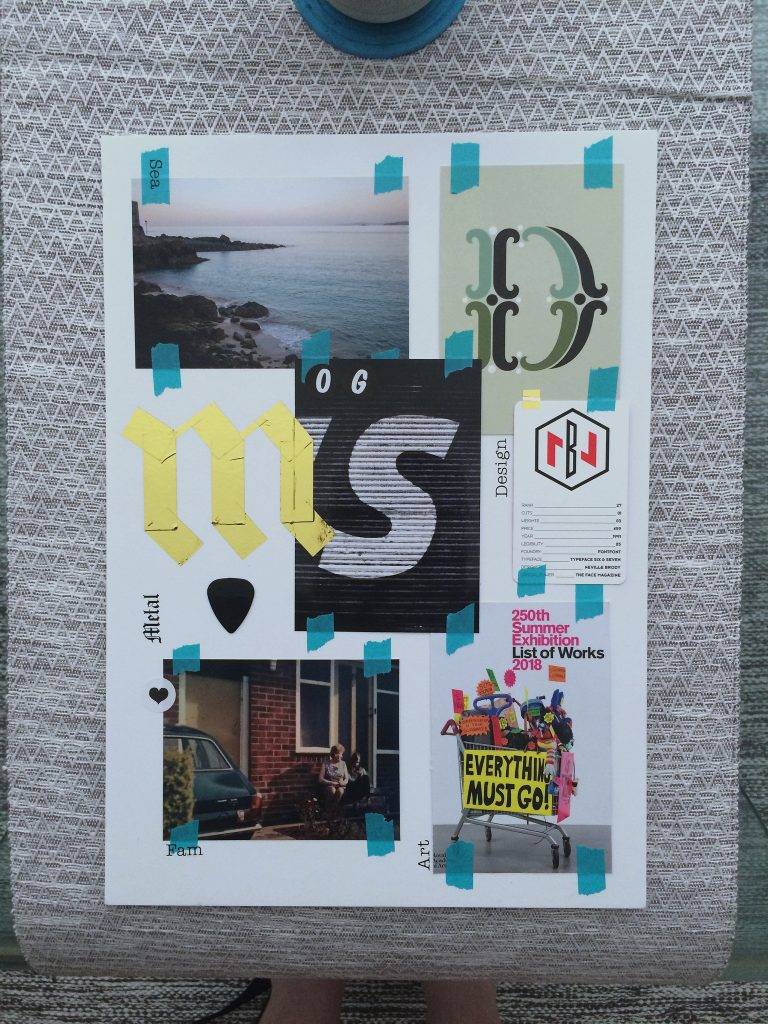
Source: Sam Town, 2018. Attribution: CC BY-SA 2.0
Retrieved from: https://www.flickr.com/photos/future-rustic/42378204614
In “Contextmapping: Experiences from Practice,” Visser, Stappers, Van Der Lught and Sanders include a diagram, shown in Figure 1.3, that illustrates how the different types of information gathering techniques during the Empathize phase provide varying levels of understanding about the user.
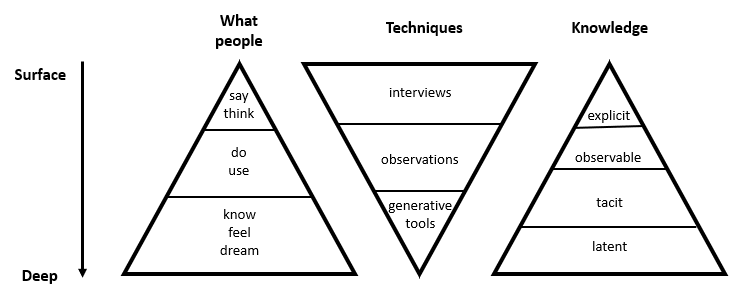
Source: Visser, Stappers, Van Der Lught & Sanders, 2005, p. 123
When the ideas from Design Thinking are applied within a classroom, there are many opportunities, even with young students, for critical thinking that reaches beyond the expected science, math and engineering insights traditionally associated with DBL. The left triangle in the diagram in Figure 1.3 reminded me of character analysis in fiction. What the character says and does in a story may be very different than the internal dialogue that reveals his or her true feelings. This practice of looking below the surface is an important analytical and social-emotional tool that students can use throughout their lives.
Empathy as Part of Social-Emotional Learning
Though human brains are wired for empathy, children still need to learn how to develop it. They do this by watching and listening to adults and peers, observing how empathy is shown and why it is important (Jones, Weissbourd, Bouffard, Kahn, & Anderson). Through The Making Caring Common Project, Harvard Graduate School of Education has developed a list of five steps for schools to promote and teach empathy:
- Model empathy
- Teach what empathy is and why it matters
- Practice empathy
- Set clear ethical expectations
- Make school culture and climate a priority
Steps 1-3 above are integral to a Design Thinking DBL project. As teachers explain the Design Thinking process, they convey to students why the empathy phase is essential to solving a user’s needs and why it is important to care about people they may not know or identify with in their community and beyond. Teachers may give examples of how Design Thinking has been used to develop successful products or services by sharing stories, images or video. They might also show examples of what happens when the Empathize phase is skipped and products fail. Finally, Design Thinking DBL gives students the opportunity to practice empathy by deepening their listening and observation skills as they try to understand what the user needs. In turn, they model empathy within their classrooms and for the rest of the school.
The video below shows how empathy for children across the world with limited access to clean water helped students in a school in San Diego design potential solutions to the clean water problem.
Source: Edutopia, September 19, 2018
Retrieved from: https://www.edutopia.org/video/design-thinking-problem-solving-framework
Implementing the Empathize Phase in the Classroom
It seems almost too good to be true that Design Thinking as part of a DBL project not only fosters cross-disciplinary academics but also social-emotional learning. Many teachers might wonder how they could possibly find time to design and prep students for these types of projects, let alone lead them to successful outcomes. Like anything else, it helps to learn from those who have done it. David Lee, the elementary Design Innovation Specialist at Singapore American School in Singapore, has a website with links to many resources, a book, Design Thinking in the Classroom, and videos summarizing Design Thinking projects he has done with his students. The video below describes projects his students did to improve perceived problems in their school environment.
Retrieved from: https://www.youtube.com/watch?v=Y5tumfLc-Wo
I found his examples and suggestions in Design Thinking in the Classroom to be very insightful for the Empathize phase and have tried to summarize them below.
Have Beginner’s Mindset
Encourage students to approach problems with a beginner’s mindset “since empathy cannot be truly attained when students think they already know enough about a topic” and “students need to be aware of and put aside their biases and assumptions” (p. 41). This can be difficult with younger students because they are in the early stages of developing the ability to empathize. In an example of a first grade project where students were tasked with developing a tool to help a classmate improve a specific family activity, some students couldn’t help but design something that THEY wanted as opposed to what their classmate needed. Lee said he had to “reiterate continually” that students needed to turn “their focus away from themselves to see that their end user was more important in the context of their design challenge” (p. 51).
Start Small
In the first grade project described in the previous paragraph, the users and designers were classmates. That kept all research, observations and interviews within the classroom walls so Lee could keep an eye open to what was going on and provide help as needed. It also gave students practice interviewing with people they already knew.
Provide Support
Lee suggests that especially with the younger grades, teachers will need to find and contact experts and users. Though he believes students should be encouraged to develop interview questions, particularly as a whole-class project, teachers did, when faced with time constraints, prepare questions. Teachers also prepped those being interviewed about the project and the types of questions they would be asked.
Encourage Storytelling & Conversations
Lee stresses the importance of encouraging storytelling, asking broad questions and using “Why?” to uncover the user’s hidden feelings and desires. He also found that using the word “interview” made for awkward moments between the kids and the people they were talking to. Instead, he told the students to “have a conversation” with the experts and users and group questions logically so that the interaction had a more natural flow.
Listen, Take Good Notes & be a Detective
One of the excellent side benefits of the Empathize phase of Design Thinking is that student designers must listen closely to what their users are saying without interrupting them. It’s every teacher’s dream! Lee reminds students they must write down exactly what is said so that no insight is lost due to interpretation. (Though he doesn’t say this, it might be easier for younger students to video or audio record interviews as it would be difficult for them to accurately write down every word.) Students must also act as detectives, looking at everything within the user’s environment with the beginner’s mind and fresh eyes in order to catch things that the user’s words don’t. They can use video and cameras to help with this so the settings can be easily revisited.
Digital Tools for the Empathize Phase
Topic ideas for students & Teachers
Here is a sampling of websites that can give teachers and older students empathy-based design topic ideas.
Discover Design.org an online platform where students, teachers, and mentors come together to design solutions for real-world challenges
Nearpod + Participate Lessons on the United Nations 17 Sustainable Development Goals offers a series of free lessons for 6-12th grade that could be used to provide background and topic ideas for a Design Thinking DBL project.
The K-12 Lab Wiki lists Design Thinking Challenge Ideas as well as many other resources for Design Thinking in education.
Do Something.org Teens can sign up to volunteer, engage in social change or civic action campaigns. Lots of inspiring ideas for how student action based on empathy makes a difference in the world.
ToOls for Research, observation and Synthesis
Students can use tablets, phones, and digital cameras to capture images, audio, and video as they interview and observe users. They can utilize the following software for notetaking, interacting with users, and organizing their research.
- Notetaking applications such as OneNote, EverNote, and Notability make it easy to type and organize notes and record audio. OneNote even allows you to record video within the app.
- Mind mapping apps such as Padlet can be useful to lay out artifacts for organization, viewing, and synthesis (see Figure 1.4).
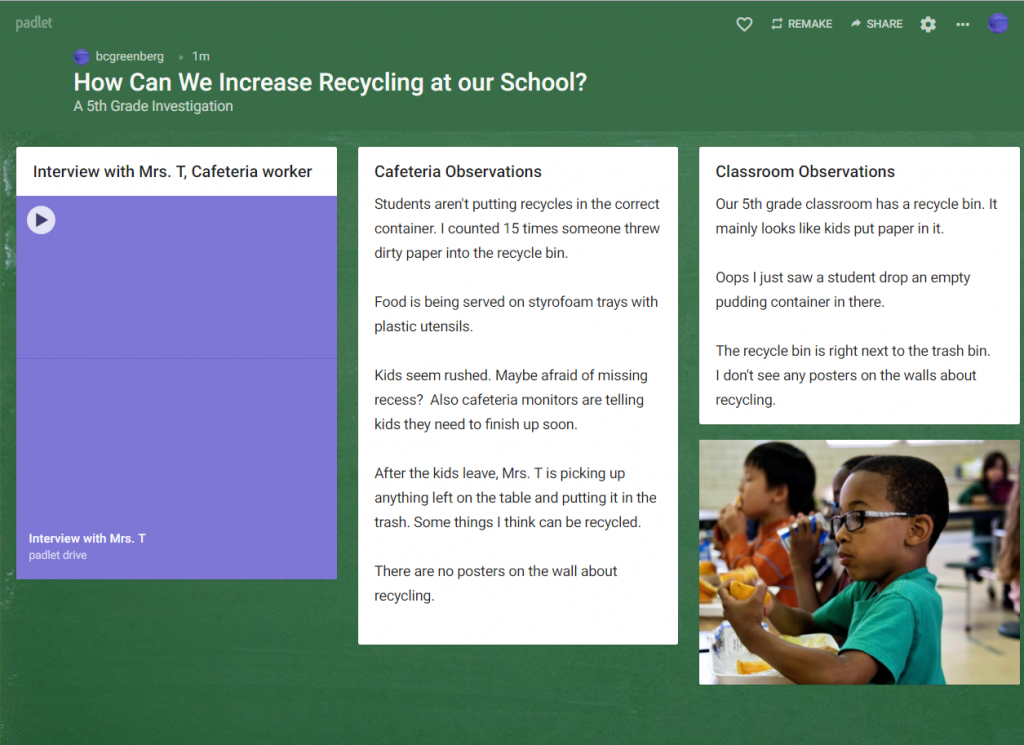
- If interviews can’t be done in person, classes can use Skype, FaceTime, or Google Hangouts to meet with experts and users remotely.
- One of the students in my cohort introduced us to Listenwise, an NPR website with radio-based stories on current events, social studies, ELA, and science topics. I found this story on the use of Virtual Reality games used to immerse students in the reality of the war in Syria. As VR becomes more readily available in schools, it could prove to be a powerful source for promoting empathy among students for people outside their immediate communities.
Producing Innovative (and Empathetic) Designers
Design Thinking provides an immersive way for students to develop the skills needed to be what the ISTE Student standard 4 refers to as an “Innovative Designer.” Part of this standard refers to “students
exhibit(ing) a tolerance for ambiguity, perseverance and the capacity to work with open-ended problems” (ISTE Student Standards, 2016). There is no more open-ended, ambiguous challenge than truly understanding the needs of another person. Other than studying literature, I can’t think of a better way to learn about empathy through school subjects than projects that incorporate Design Thinking.
References
An introduction to design thinking process guide. Institute of Design at Stanford. Retrieved from: https://dschool-old.stanford.edu/sandbox/groups/designresources/wiki/36873/attachments/74b3d/ModeGuideBOOTCAMP2010L.pdf
Context Mapping Basics. Retrieved 2/9/19 from: http://contextmapping.com/basics/
Delahoussaye, J. (2015). NPR.org. Virtual games try to generate real time empathy for faraway conflict. Retrieved from: https://listenwise.com/teach/events/311-empathy-war-and-video-games
ISTE Standards for Students (2016). Retrieved from: https://www.iste.org/standards/for-students
Design Thinking: a problem solving framework (2018). Edutopia. Retrieved from: https://www.edutopia.org/video/design-thinking-problem-solving-framework
Jones, S., Weissbourd, R., Bouffard, S., Kahn, J. & Anderson, T. R. (2018). For educators: How to build empathy and strengthen your school community. The Making Caring Common Project, Harvard Graduate School of Education. Retrieved from: https://mcc.gse.harvard.edu/resources-for-educators/how-build-empathy-strengthen-school-community
Kriek, D. (2018). Everything you need to know about Context Mapping (in just one paragraph). Medium. Retrieved from: https://medium.com/@DoKriek/everything-you-need-to-know-about-context-mapping-in-1-paragraph-8f6edb27e87
Lee, David (2018). Design thinking – improving school experiences and helping teachers. Retreived from: https://www.youtube.com/watch?v=Y5tumfLc-Wo&t=4s
Lee, David (2018). Design Thinking in the Classroom. Berkeley: Ulysses Press.
Visser, F.S., Stappers, P.J., Van Der Lught, R. & Sanders, E. (2005). Contextmapping: Experiences from practice. CoDesign, (1)2, pp. 119 – 149. Retrieved from: http://web.a.ebscohost.com.ezproxy.spu.edu/ehost/pdfviewer/pdfviewer?vid=3&sid=b2dae68a-fd44-4770-b937-7ce143e016f4%40sdc-v-sessmgr04
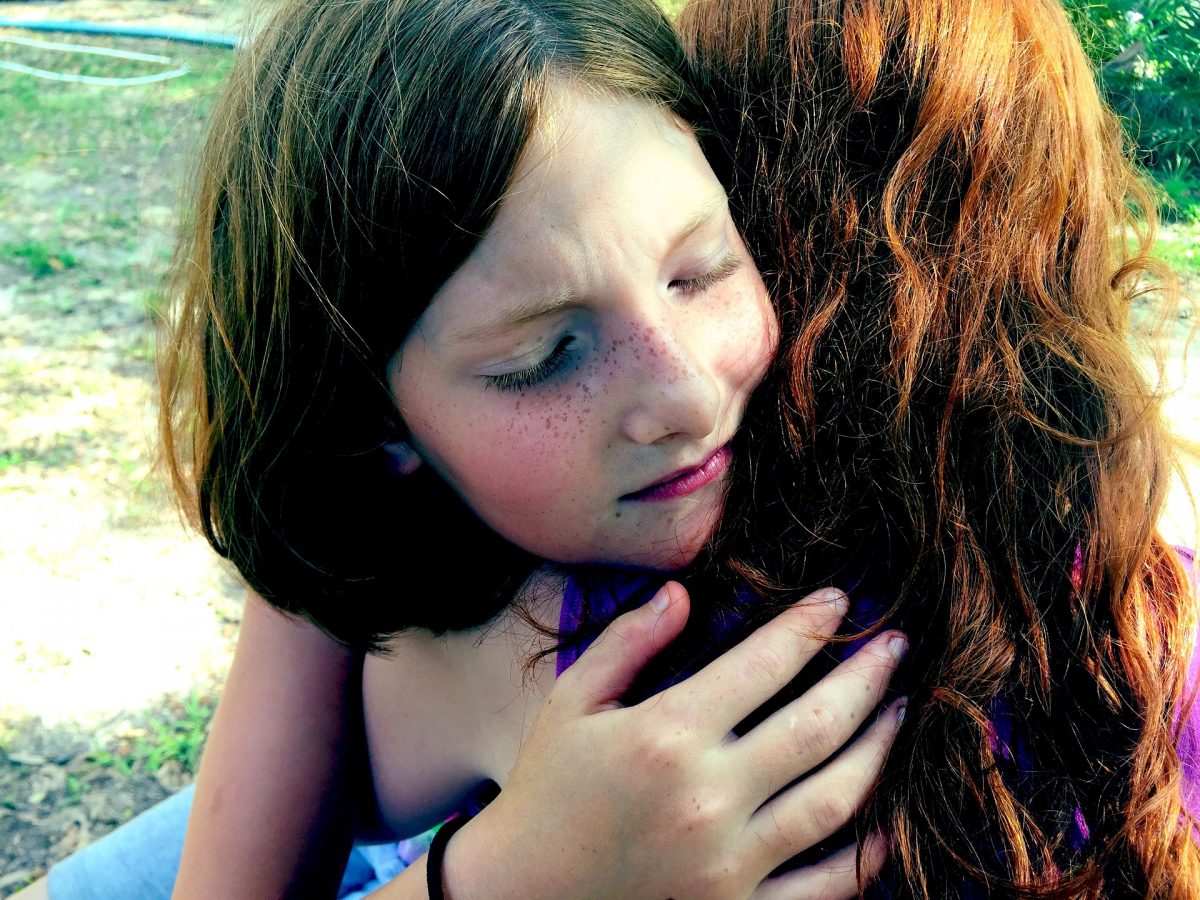
Wow, Bridget ~ This was a really inspiring and informative post – I love that you focused in so deeply on empathy because you’re right about it being the essential ingredient! The video with David Lee opened my eyes up to the possibilities of Design Thinking and the very real impact it can have on schools and students – so blown away! I appreciate the way you included the gradual release style of teaching Design Thinking for younger students, also. I often start doubting some of these processes with younger students and this reminds me that it is especially important to start this at a young age. The extensive list of tools you mention using is also really helpful. I am going to bookmark this blog post to reference back to because there are so many great ideas and resources – thank you! And I am excited to follow David Lee’s youtube channel, blog, website, etc – what a resource rich educator…I am pretty giddy about diving deeper into all of what he has to offer!
Thank you for reading the post, Christine! I’m excited about all the resources David Lee offers too. I think we need to convince him to do a speaking engagement tour of the U.S.!
Bridget,
You gave so much helpful information on empathy which is an essential step for a design based learning. You listed suggestions and also introduced digital tools which can help with empathy phase. From your blog, I understand how important empathy is in DBL and how the teachers can do to scaffold students to foster this mindset. Thanks for your sharing.
Bridget- Your post is very inspiring, and I loved the way the way you categorized the information you found! I liked how students practiced interviewing people they already knew and had “conversations” rather than “interviews”. I also appreciated the tools you provided for note-taking and mind-mapping. You did a great job connecting Empathy to a Designers mindset and providing real-world examples throughout your post. Thank you for sharing your research!
Thanks for all your research and insights on the empathy part of design thinking. Design thinking is a powerful tool and the empathy stage really sets the foundation for the work ahead. I appreciated that you drew attention to developing empathy in children. You are so right. Our brains are naturally wired for it but we must cultivate and develop it.
I thought all your ideas were very appropriate and applicable to the classroom. Thanks for compiling this great resource. I will definitely utilize this when planning out the empathy phase of a design thinking project. Thanks!